Valley of Geysers (Kamchatka Territory) - the largest collection of geysers
Valley of Geysers (Kamchatka Territory)
The Valley of Geysers in Kamchatka is one of the largest clusters of geysers
in the world, and the only one in Eurasia.
The Valley of Geysers is located on the territory of the Kronotsky State Natural Biosphere Reserve,
which is included in the list of UNESCO World Natural Heritage sites in the “Volcanoes of Kamchatka” category.
Among the mountains of the Eastern volcanic belt, at an altitude of more than five hundred meters, in the basin of one of the tributaries of the Shumnaya River, there is one of the wonders of the world - the Valley of Geysers.
The valley of geysers is the name given to the bowl of an ancient lake that disappeared many centuries ago, deeply dissected along the bottom by a mountain river. Geysers are jets of boiling water that burst to the surface from the hot bowels of the Kikhpinych volcano.
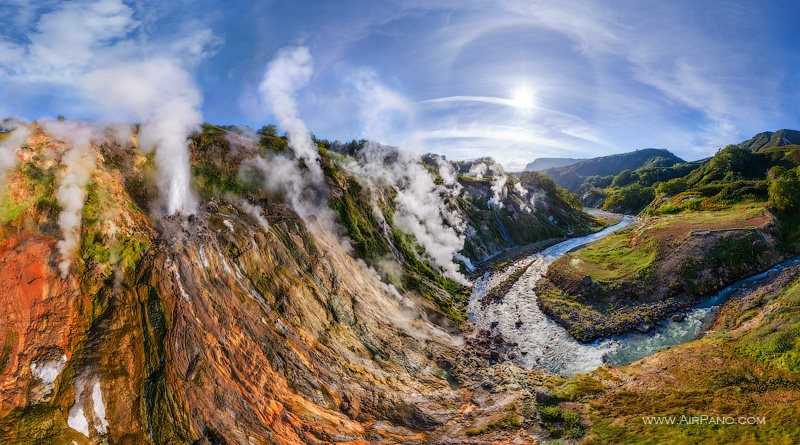
The Valley of Geysers was discovered in 1941. The discoverer Tatyana Ivanovna Ustinova, a geologist of the reserve, together with guide Krupenin, trying to find the answer to the question of why the water in one of the rivers is warmer than in others, fell under the stream of a geyser. This geyser was later named “Firstborn”. This is how one of the largest geographical discoveries twentieth century.
What is the Valley of Geysers? This is a mountain river canyon, where over an area of seven square kilometers there are more than twenty large geysers. Each of these geysers is unique and unique. Has its own name and character.
"Giant" spews to the height of a nine-story building
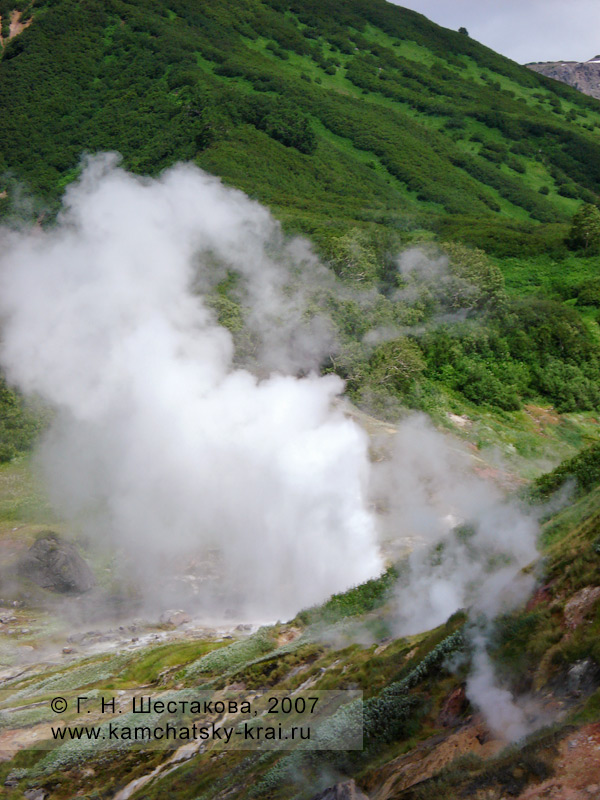
thirty tons of water in one minute, and “Triple” gushes out of three holes at once, “Big” from a huge griffin shell creates a unique water cascade, and “Firstborn” from under a block of stone throws a stream of boiling water directly into the river.
“Sugar” gushes upward with a crown sparkling in the sun, and “Fountain” creates a narrow “milky” stream. “Leshiy” groans in a semi-submerged state, “Khrustalny” sparkles, and “Grotto” remains silent for years, so that one day it will bring down tens of tons muddy water from the slope into the river. The extravaganza of geyser-fountains is complemented by more than two hundred pulsating and gushing hot and steaming springs, steam-gas jets, cauldrons with red boiling clay, owl-hooting steaming voids, hot and warm lakes and streams with waterfalls.

The Valley of Geysers is a unique ecosystem and a special microclimate for plants and animals. Spring comes to thermal areas a month earlier than usual, at the end of April.

Brown bears, having left their winter bedrooms, gather in dozens at the geysers: they eat the first fresh greenery;

lie down on spring snowdrifts; This is where they have their mating games and rutting season. Nowhere else in Kamchatka do bears gather in such numbers in such a limited area during the rut as in the Valley of Geysers.
The Valley is unique in late autumn and early winter. Snow is quietly falling on the ground, and jets of boiling water are noisily bursting out from under the ground!
The Valley of Geysers is a unique object for eco-tourism. Famous visitors to the Valley of Geysers have included presidents, astronauts, prime ministers, artists and businessmen.
Vladimir Mosolov

The Lost World or a few final words
The Valley of Geysers is one of those few places on our planet that is definitely worth seeing. These are not dead for you , and wildlife! Yes, how unusual! The place is truly amazing, it seems like you are in some kind of prehistoric lost world.
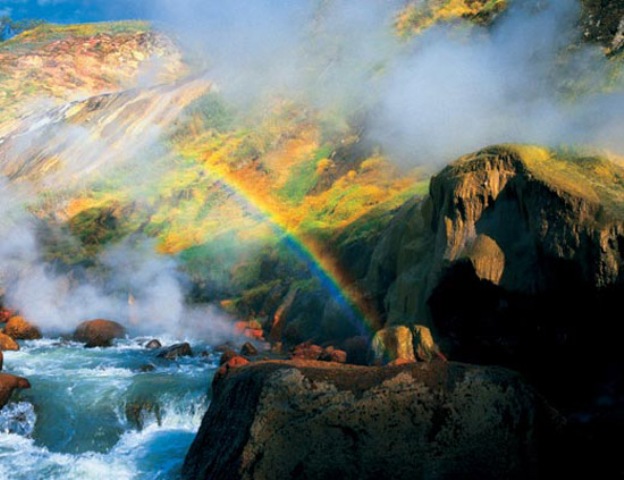


The Valley of Geysers is located on the territory of the Kronotsky State Natural Biosphere Reserve, which is included in the list of UNESCO World Natural Heritage sites in the “Volcanoes of Kamchatka” category.
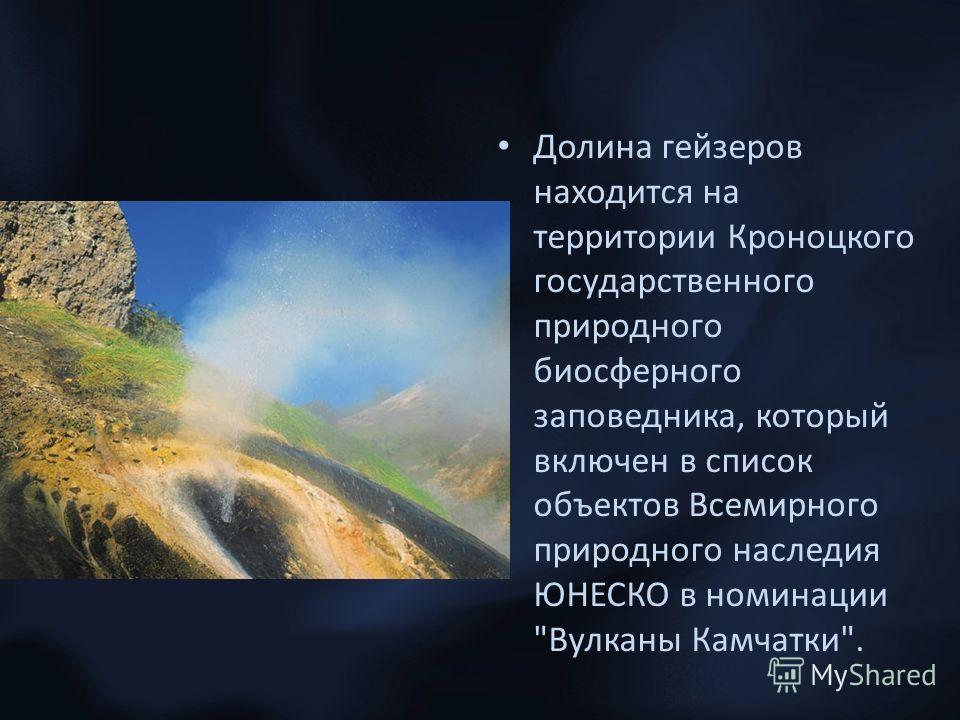
The Valley of Geysers was discovered in 1941 by employees of the Kronotsky Nature Reserve. In 2008, according to the results of a popular vote, the Valley of Geysers was included in the list of the Seven Wonders of Russia. Due to its inaccessibility and nature reserve regime, the Valley is visited by only a few thousand people a year.


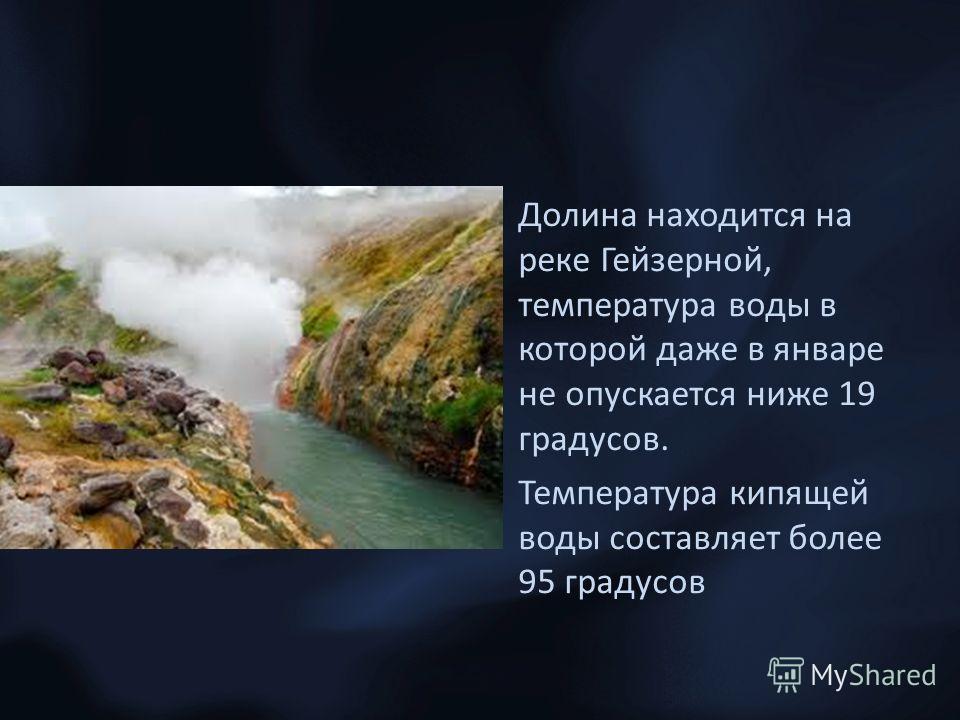
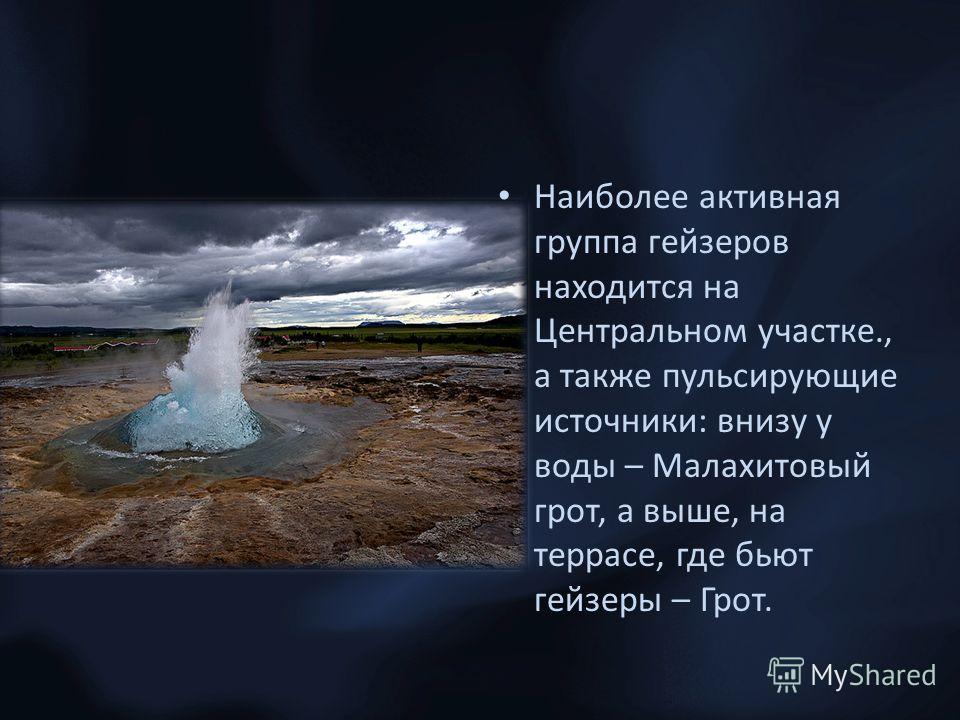
How to get to the Valley of Geysers? You can now enter the Valley only as part of organized group. There are wooden walking platforms for tourists. Excursions are carried out by helicopter. The total duration is 5–6 hours, of which about 2.5 hours are the flight, the stay on the route is 1.5–2 hours. Regular excursion flights are made in the summer-autumn period.
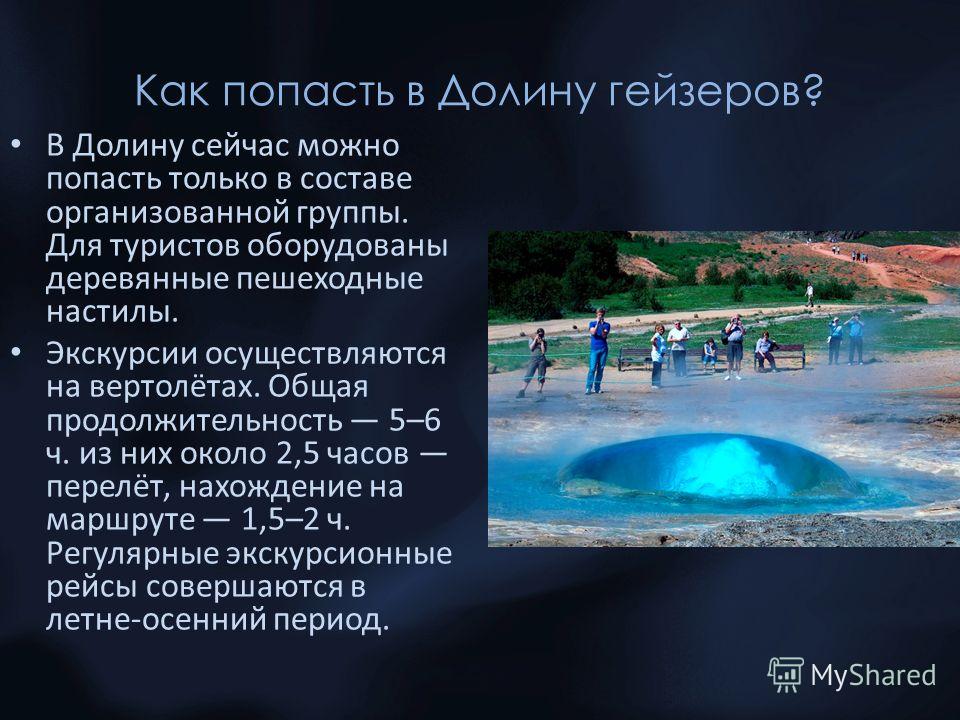
Climate and weather On the territory of the Kronotsky Reserve the climate is maritime, summers are short and rainy, winters are quite warm and snowy, winds and storms are frequent. The average temperature in August is +12°C (maximum +24°C), the average temperature in February is -7°C (minimum -25°C).

Valley of Geysers
The presentation was prepared by a student of grade 8"B"
Ershova Daria
clusters of geysers in the world "Volcanoes of Kamchatka"
The Valley of Geysers in Kamchatka is one of the largest clusters of geysers in the world, and the only one in Eurasia. The Valley of Geysers is located on the territory of the Kronotsky State Natural Biosphere Reserve, which is included in the UNESCO List of World Natural Heritage Sites in the “Volcanoes of Kamchatka” category. The Valley of Geysers was discovered in 1941 by employees of the Kronotsky Nature Reserve, geologist Tatyana Ustinova and observer Anisifor Krupenin. Since then it has been a recognized tourist pearl of Kamchatka and the Far East.
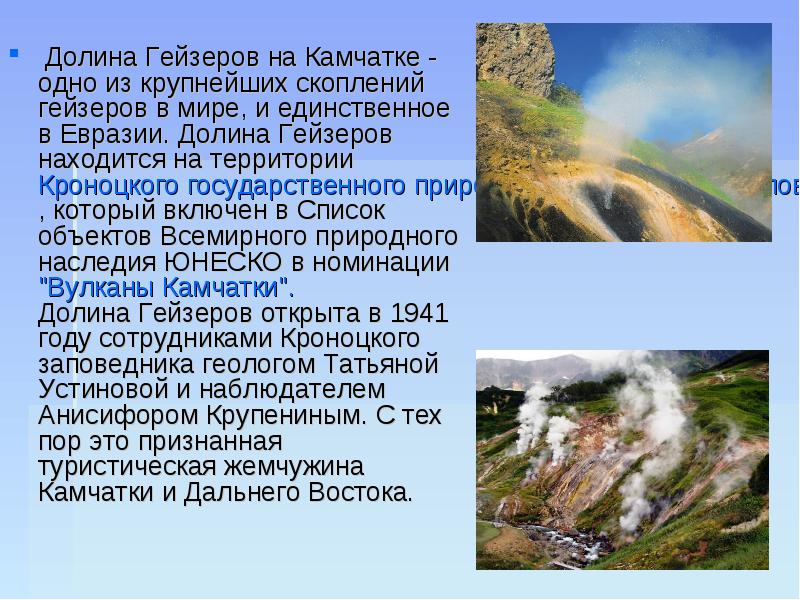
"King" of the Valley of Geysers
The “King” of the Grotto valley is the first geyser in size. The dimensions of his bath are 2 by 2.5 meters. When it erupts, it releases up to 60 tons of boiling water, at an angle of approximately 45 degrees. It is believed that it was the Grotto that knocked out a huge flat area on the slope of the Valley of Geysers canyon. Now the geysers Fontan and New Fontan are located here. The operating mode of the Grotto geyser has not been established even 7 decades after its discovery in the Kronotsky Nature Reserve.
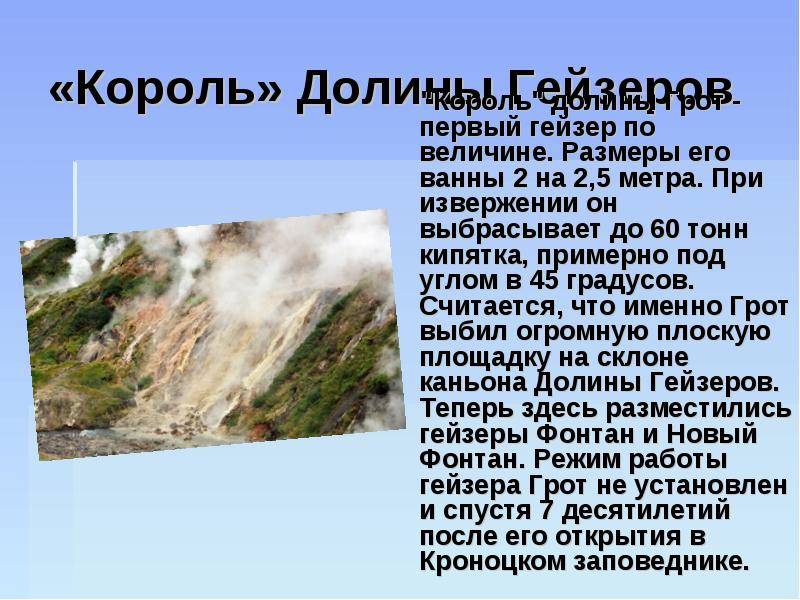
eight geyser sites
The Valley of Geysers begins with the Pervenets geyser, gushing every 10-17 minutes. Next, a geyser appropriately named Triple ejects boiling water through three holes in the ground. And on the seventh geyser site, the Giant geyser rarely (cycle: 2-6 hours), but powerfully erupts. The eruption of the largest of the geysers of the Giant Valley begins with a powerful splash. Then the column of water shoots up to a height of 30 meters, and the clouds of steam rise to a height of 300 meters and above. There are eight geyser areas in total in the valley, the last one has the notable Weeping Geyser, pulsating with hot tears.

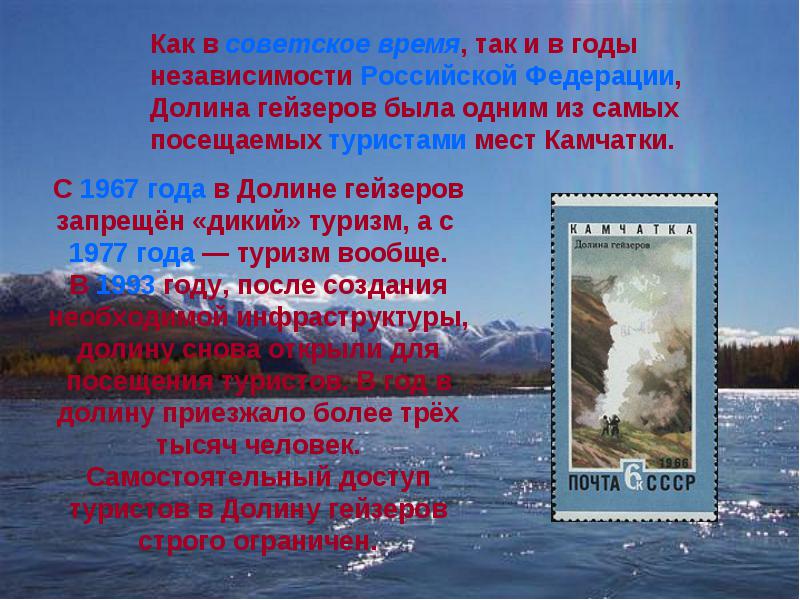
Typhoon Elsa 1981
In 1981, Typhoon Elsa caused rains, which caused the water level in the Geysernaya River to rise by several meters. Mud flows carried three-meter boulders along the riverbed, destroying everything in their path. Damaged, including the famous Malachite Grotto. The Big Pechka Geyser has disappeared.
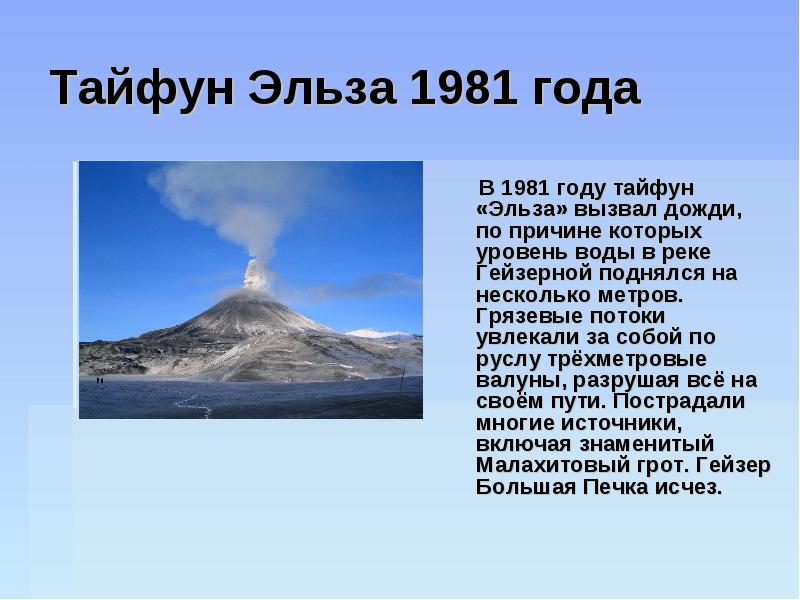
Mudflow 2007
June 3, 2007 several powerful mudflows collapsed onto the valley, covering most of it with mud and stones, blocking many springs. A natural dam has also formed, if it breaks, a lake can form that will cover almost all sources with a layer of water. The tourists and staff in the valley were urgently evacuated, so casualties were avoided.
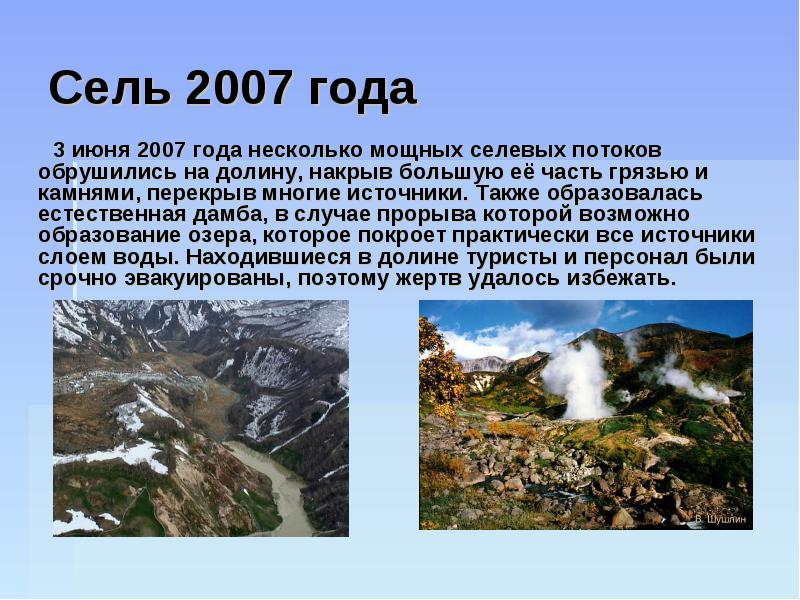
List of main geysers before the 2007 mudflow
Pervonets is the first geyser that Tatyana Ustinova and Anisifor Krupenin saw during their study of the tributary of the Shumnaya River. The only geyser site lying outside the Geysernaya River valley.
Giant
Slit - a stream of steam shoots out of the slit
Triple - three jets of steam
Malachite grotto
Pearl
Sugar
Cone
Fountain
Small
Big
Double
Fickle
Gate of Hell

Additional facts
In 1972, the filming of the film “Sannikov Land” took place in the Valley of Geysers.
Part of the valley enters the caldera of the Uzon volcano. In the Uzon caldera in 2008, the formation of the Mutny geyser occurred.
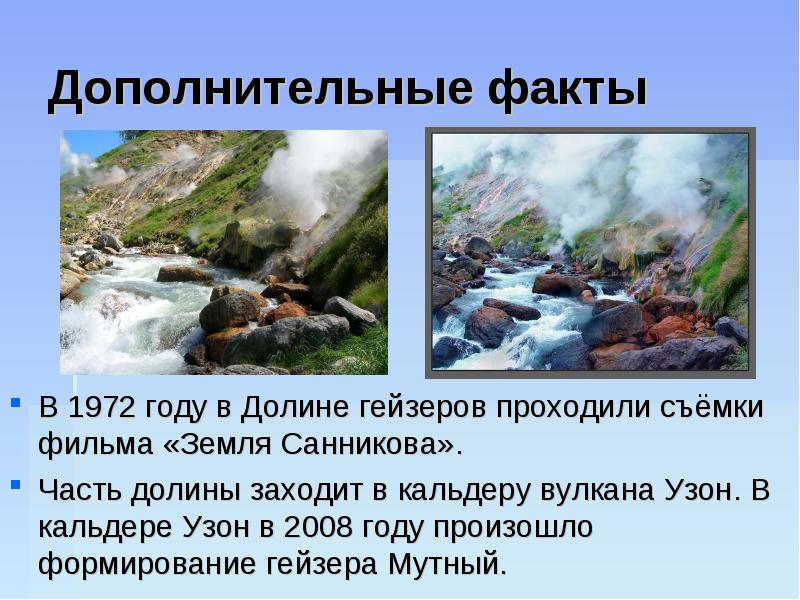
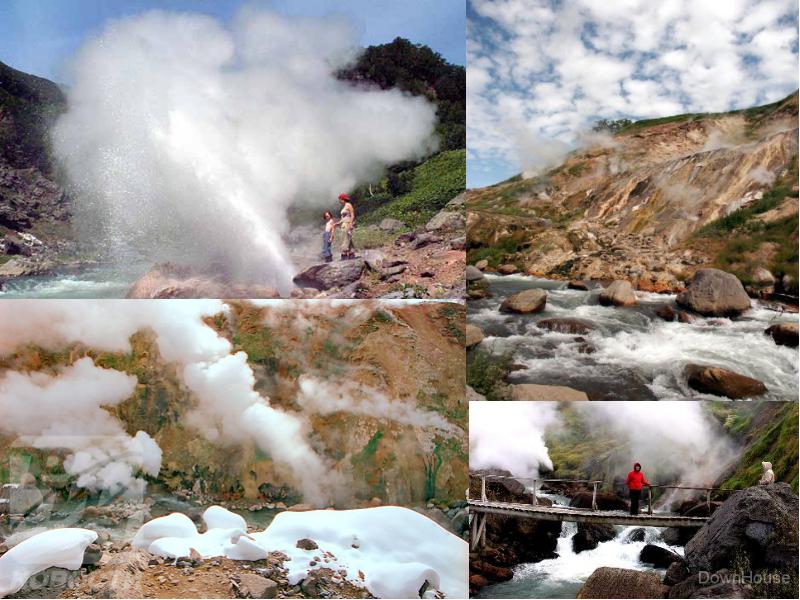
End
Thank you for your attention!

"Volcanoes of Kamchatka"
The Valley of Geysers in Kamchatka is one of the largest clusters of geysers in the world, and the only one in Eurasia. The Valley of Geysers is located on the territory of the Kronotsky State Natural Biosphere Reserve, which is included in the UNESCO List of World Natural Heritage Sites in the “Volcanoes of Kamchatka” category. The Valley of Geysers was discovered in 1941 by employees of the Kronotsky Nature Reserve, geologist Tatyana Ustinova and observer Anisifor Krupenin. Since then it has been a recognized tourist pearl of Kamchatka and the Far East.

"King" of the Valley of Geysers
The “King” of the Grotto valley is the first geyser in size. The dimensions of his bath are 2 by 2.5 meters. When it erupts, it releases up to 60 tons of boiling water, at an angle of approximately 45 degrees. It is believed that it was the Grotto that knocked out a huge flat area on the slope of the Valley of Geysers canyon. Now the geysers Fontan and New Fontan are located here. The operating mode of the Grotto geyser has not been established even 7 decades after its discovery in the Kronotsky Nature Reserve.

The Valley of Geysers begins with the Pervenets geyser, gushing every 10-17 minutes. Next, a geyser appropriately named Triple ejects boiling water through three holes in the ground. And on the seventh geyser site, the Giant geyser rarely (cycle: 2-6 hours), but powerfully erupts. The eruption of the largest of the geysers of the Giant Valley begins with a powerful splash. Then the column of water shoots up to a height of 30 meters, and the clouds of steam rise to a height of 300 meters and above. There are eight geyser areas in total in the valley, the last one has a noteworthy Crying Geyser, pulsating with hot tears.


Typhoon Elsa 1981
In 1981, Typhoon Elsa caused rains, which caused the water level in the Geysernaya River to rise by several meters. Mud flows carried three-meter boulders along the riverbed, destroying everything in their path. Many springs were damaged, including the famous Malachite Grotto. The Big Pechka Geyser has disappeared.

Mudflow 2007
On June 3, 2007, several powerful mudflows hit the valley, covering most of it with mud and stones, blocking many springs. A natural dam has also formed, if it breaks, a lake can form that will cover almost all sources with a layer of water. The tourists and staff in the valley were urgently evacuated, so casualties were avoided.

List of main geysers before the 2007 mudflow
Pervonets is the first geyser that Tatyana Ustinova and Anisifor Krupenin saw during their study of the tributary of the Shumnaya River. The only geyser site lying outside the Geysernaya River valley.
Giant
Slit - a stream of steam shoots out of the slit
Triple - three jets of steam
Malachite grotto
Pearl
Sugar
Cone
Fountain
Small
Big
Double
Fickle
Gate of Hell

Additional facts
In 1972, the filming of the film “Sannikov Land” took place in the Valley of Geysers.
Part of the valley enters the caldera of the Uzon volcano. In the Uzon caldera in 2008, the formation of the Mutny geyser occurred.

